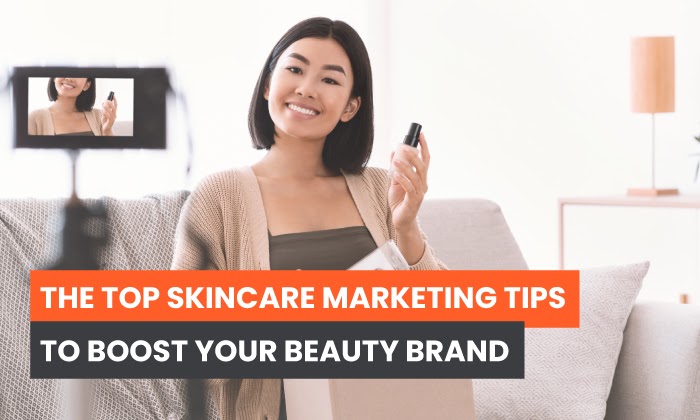
The skincare space makes over $17 million in revenue each year, and it’s expected to grow by 5.3% annually. And as people stay home more, the desire for self-care products, including skincare, continues to expand.
This may make it the perfect time for brands to take a hard look at their skincare marketing strategies and seize on this growth.
That’s exactly what Skincare by Alana did. Founder Alana Mitchell already had $3 million in annual revenue, but she knew there was room for improvement. So, she signed up with a full-service marketing and SEO solution with my digital marketing agency.
With guided content marketing, link-building, and influencer marketing, she increased her revenue by 150%.
In this article, I’ll take you through steps you can take to improve your skincare marketing strategy using examples from Skincare by Alana and other beauty industry leaders.
Step 1: Make Some Skincare Marketing Technical Improvements
We wanted to grow Skincare by Alana’s organic traffic, so we started by making technical SEO improvements on the site. That helped her products appear more often and higher up in searches.
We worked on link building to drive traffic to the site as well.
By making those improvements, Skincare by Alana boosted its organic traffic by 275%.
Finally, we implemented A/B testing to improve conversions, which then grew by 200%.
Step 2: Add Testimonials to Your Skincare Marketing Product Web Pages
Testimonials are a powerful tool for increasing conversions. The vast majority of online buyers make their purchasing decisions based on product reviews and testimonials.
In fact, showing reviews can increase your conversion rate by as much as 270%.
You can also draw customers in by including proof your products work through testing certifications from respected organizations.
Finally, if you have approval from environmental, animal-cruelty prevention, or other socially conscious organizations, you can also increase your conversion rate.
Step 3: Identify Your Skincare Marketing Audience
Marketing your products without knowing your audience inside and out is like tossing out messages in a bottle. You don’t know who will end up reading them—if anyone ends up reading them at all.
Once you know your audience, you’ll see how you should talk to them, what issues they care about, what influencers they follow, and where they are on social media. Additionally, analyzing your audience at regular intervals will tell you who is buying your product, a demographic that can shift over time.
CeraVe, a mass-market skincare line recommended by dermatologists, recently found a new audience in Gen Z consumers, thanks to TikTok. When influencer Hyram Yarbro featured the clinical, no-nonsense brand, parent company L’Oreal reached out to him.
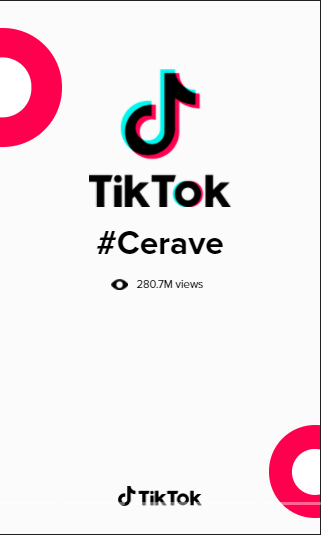
The influencer and the brand forged a partnership to create content for both TikTok and YouTube, two platforms with massive Gen Z followings.
They identified a shift in their audience and pivoted to capture the market through the right channels.
Step 4: Develop Your Skincare Marketing Message
Once you know who your audience is, you can develop a strong message that speaks to them directly.
Since its founding in 1995, bareMinerals has had one clear message for its target audience: Clean Without Compromise. Their line of cruelty-free beauty and skincare products have always been free of parabens, formaldehyde, and other chemicals often found in their competitors’ products.
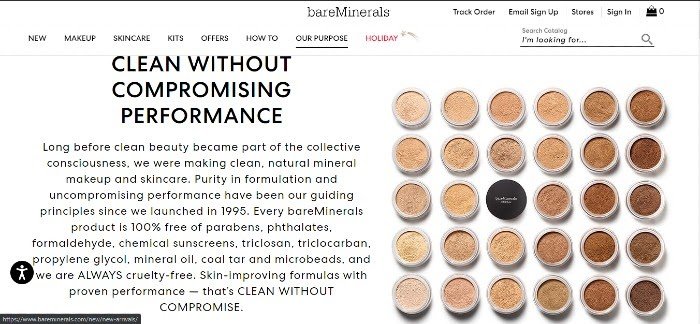
They target buyers looking for clean beauty products made by socially responsible companies. bareMinerals makes that message clear in every part of their marketing, from the site to their social accounts to their blog.
That’s the key. Once you develop a strong message for your brand, the message should be consistent across your marketing channels.
Step 5: Unleash the Potential of Skincare Content Marketing
Skincare marketing presents the perfect opportunity to create solid, consistent content addressing your target audience’s skincare questions and problems.
Skincare by Alana identified an opportunity to address skincare and self-care issues related to the pandemic. Their blog posts “Daily At-Home Skincare Routine During Quarantine and Coronavirus” and “How to Prevent Maskne—Acne Caused by Wearing a Face Mask” target key search terms that have grown month over month.
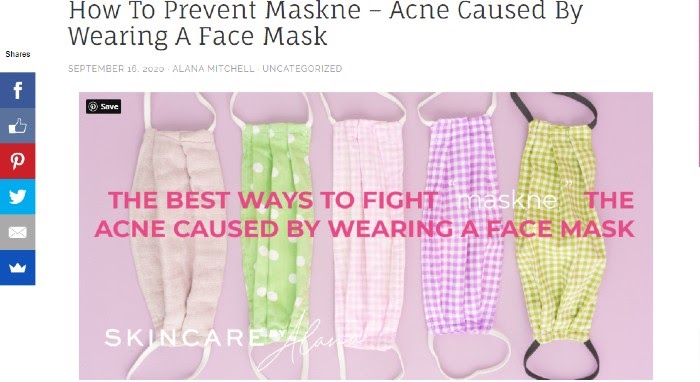
(Also, note the handy share buttons that give your content more exposure.)
Other brands use their content to communicate their values and their message through issues their audience cares about. Glossier, for instance, has created a category within their blog called Impact. This section addresses their support of the BLM movement and their commitment to creating sustainable products.
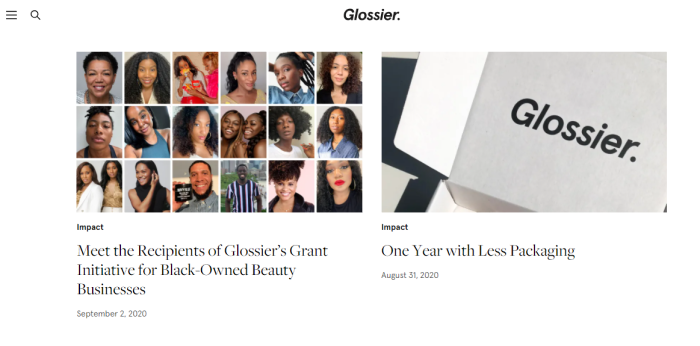
Both companies stay on top of the issues their target audiences care about and create relevant content.
Step 6: Build Your Social Media Presence to Support Your Product
Now, it’s time to grow your social presence. Your social platforms are your opportunity to share tips, announce new products, comment on social issues important to your brand, and invite your audience to engage.
The best platforms for this are usually Instagram, YouTube, Pinterest, and TikTok. All of those platforms are brimming with people sharing beauty and skincare finds, tips, and hacks.
Which of these platforms you focus on, of course, depends on your audience. Remember how CeraVe saw an uptick in sales on TikTok, which is primarily used by Gen Z consumers and the influencers they follow?
Pinterest, on the other hand, is now the third-largest social platform in the U.S., and it’s more popular with women ages 18 to 64—particularly moms. However, men make up 20% of their audience.
But the platform on many skincare brands’ radars, particularly if you’re looking to partner with influencers, is Instagram. In fact, 83% of beauty brands are working with influencers on Instagram.

In 2017, Neutrogena partnered with nine Instagram influencers to promote their Light Therapy Acne Mask. They were also YouTube personalities specializing in lifestyle content.
The campaign increased engagement by 3.7%.
You can also leverage the power of your social platforms to increase conversions. Product pins on Pinterest should link directly to your product pages on your site, for instance.
You can also set up Instapages to allow customers to shop your products from Instagram. For example, BeautyBio’s Insta Shop enables users to shop the products featured on the social media site.
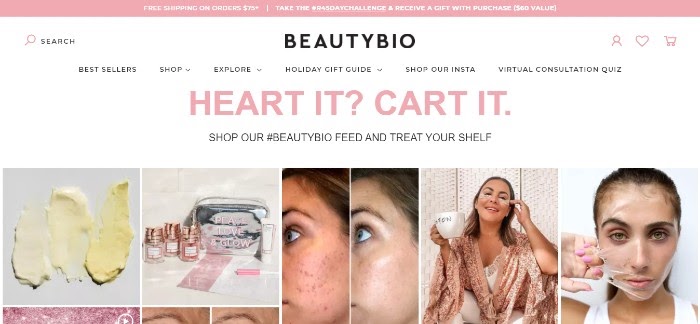
Step 7: Create a Community to Build Skincare Marketing Brand Advocacy
Building a community for your skincare brand can improve conversions as well as retention rates.
Beauty giant Sephora has created one of the more brilliant content marketing strategies.
All of their content is user generated, from their videos to their blog posts. Fans of their products and their stores post their own makeup tutorials, unboxing videos, images of trending looks, and product reviews. Sephora also hosts discussion boards on a variety of topics where users seek advice on beauty issues.
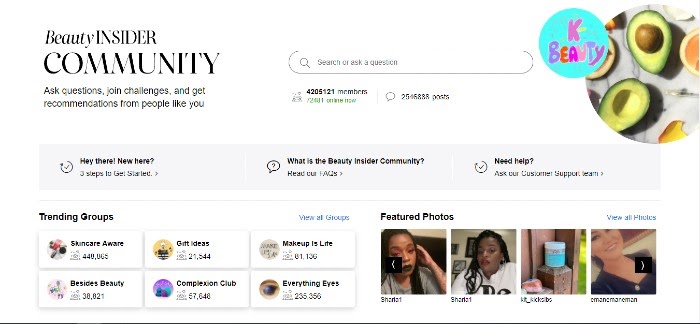
They call it the Beauty Insider Community, and that’s exactly what they’ve built. They’ve cultivated a following of over 4 million loyal users who create valuable content and market products without Sephora having to plan and execute an entire content marketing calendar.
Including exclusive (or even inclusive) events for loyal customers is another excellent way to build an engaged community.
Of course, in-person beauty events have generally been put on pause this year and into the foreseeable future. But savvy skincare brands have found ways to pivot to online events.
For example, Root, a vegan, cruelty-free, gluten-free, eco-friendly skincare brand, held their own Zoom events this year—including Mask Night, where users were invited to “grab your favorite Root mask as we hang out on Zoom.” They’ve also held virtual skincare classes.
Step 8: Build Strategic Skincare Marketing Partnerships
Strong partnerships are created through in-depth research and strategic relationship building.
Strategic partnerships take many forms, and there are endless possibilities for marketing skincare products. Retail partnerships with Walmart, Target, and Ulta, for example, have helped makeup and skincare line e.l.f. gain market share with Gen Z customers.
Others help brands put their corporate values into practice. In October, for example, Origins and its parent company, Estée Lauder, announced a partnership with chemical company SABAC and cosmetic packaging company Albea to create sustainable packaging for its products.
Finally, some partnerships create new products outright. Right now, for instance, many skincare brands are partnering with cannabis companies to market CBD-infused products.
Conclusion
Through my agency, Skincare by Alana took multiple steps to improve their skincare marketing strategy, from improving their site and content to building a community.
While you may be killing it with some of your marketing, perhaps some of the steps we laid out are missing from your strategy.
What can you do to ramp up traffic and boost your skincare marketing conversions?
The post The Top Skincare Marketing Tips to Boost Your Beauty Brand appeared first on Neil Patel.




Recent Comments